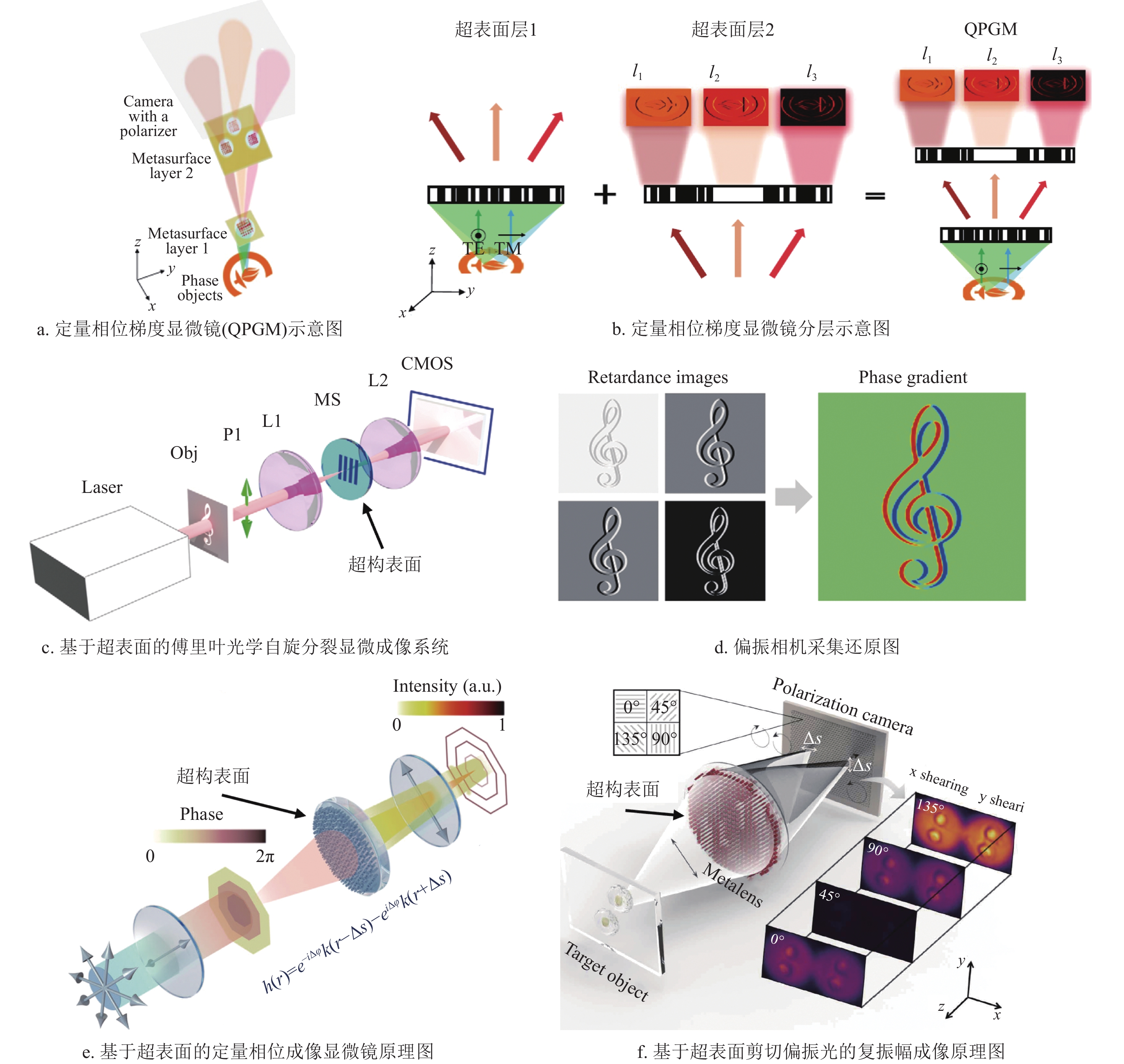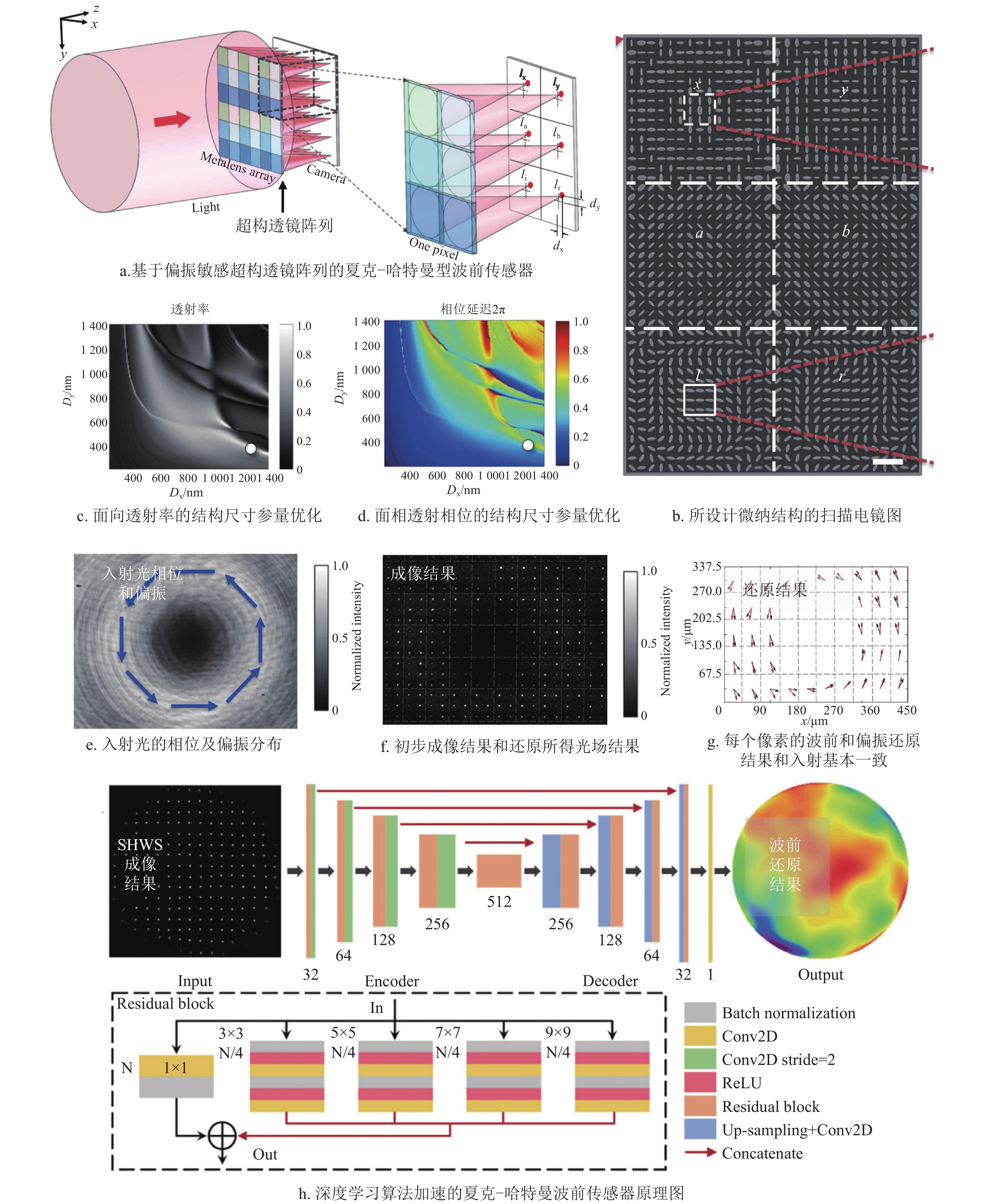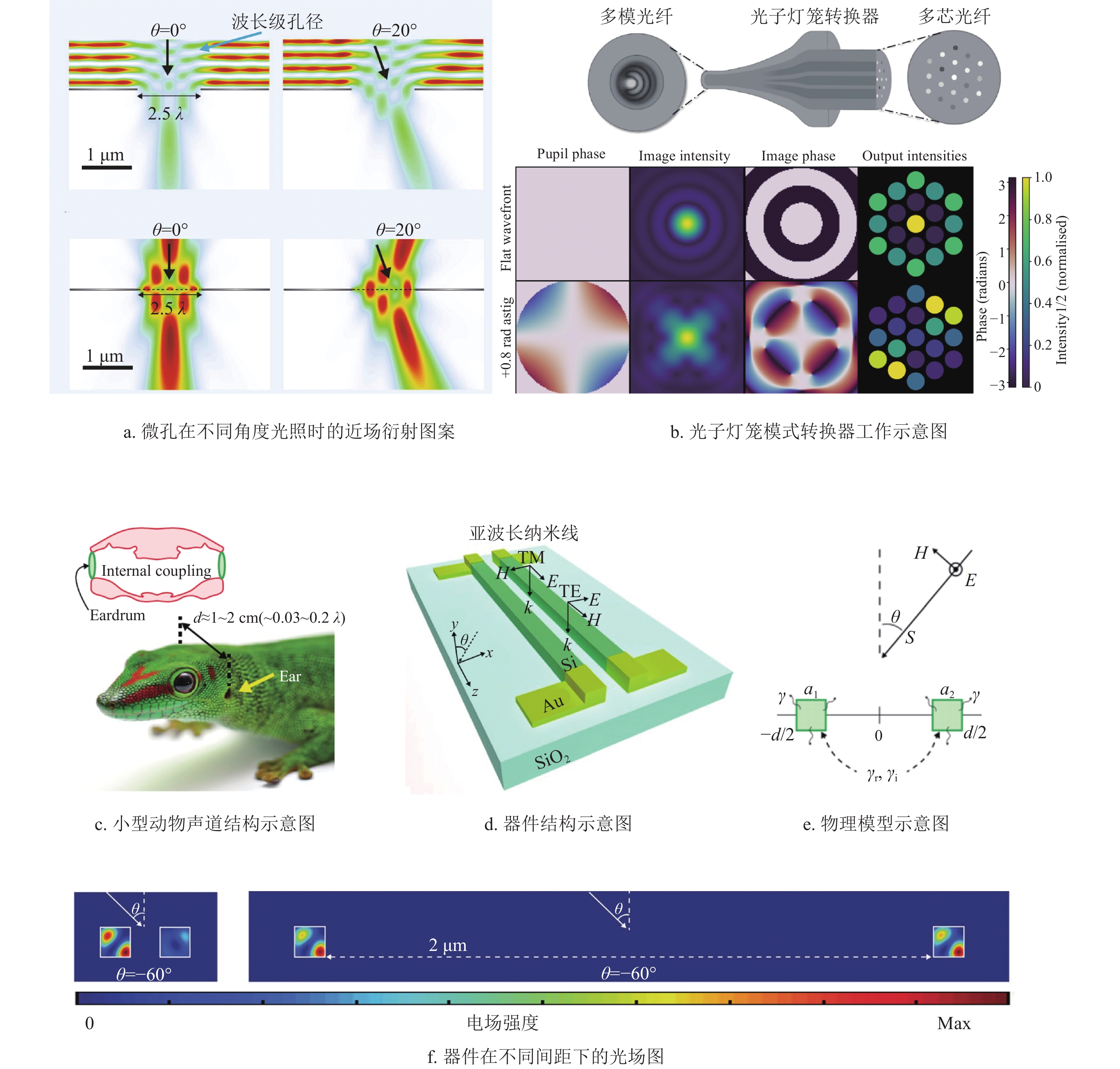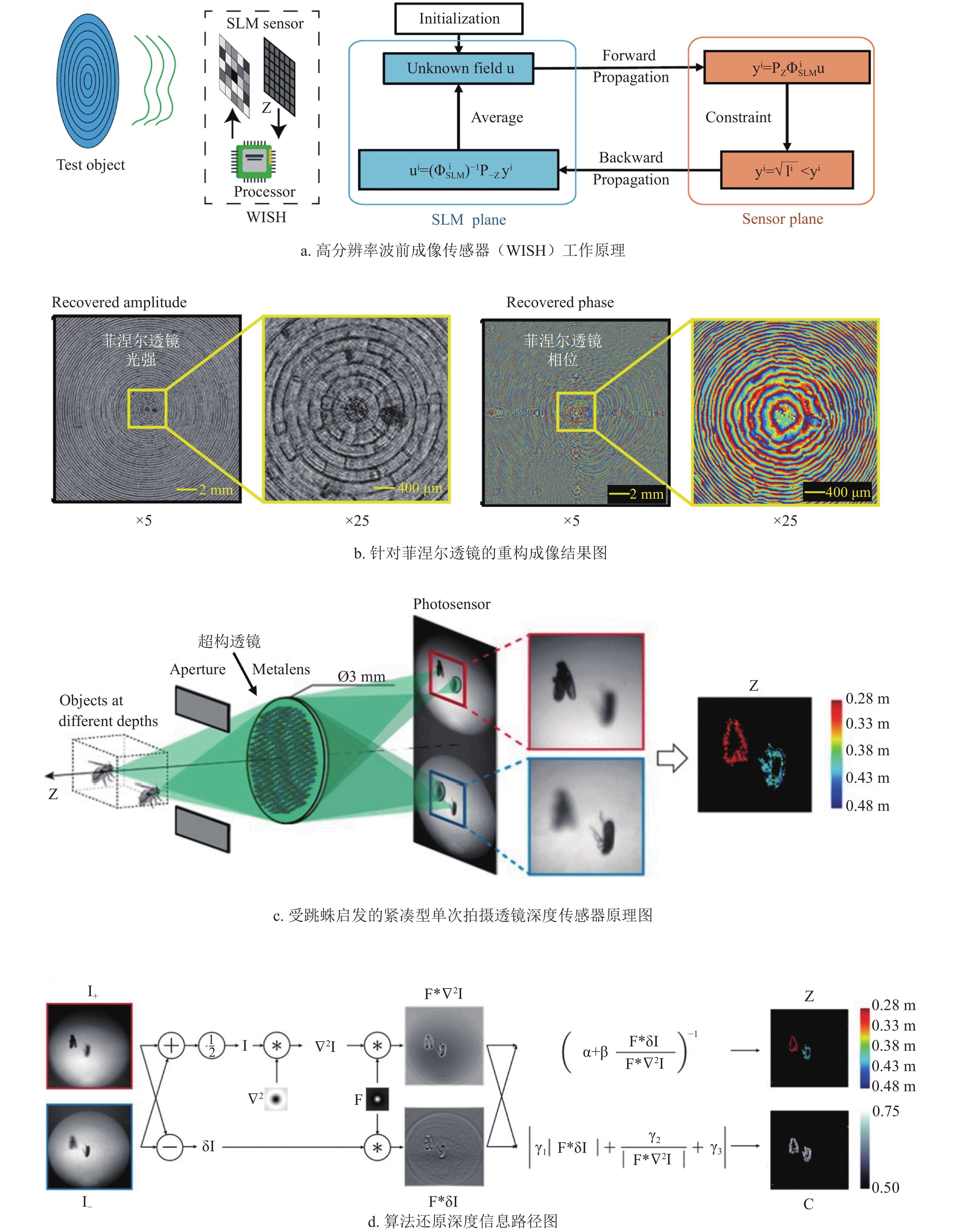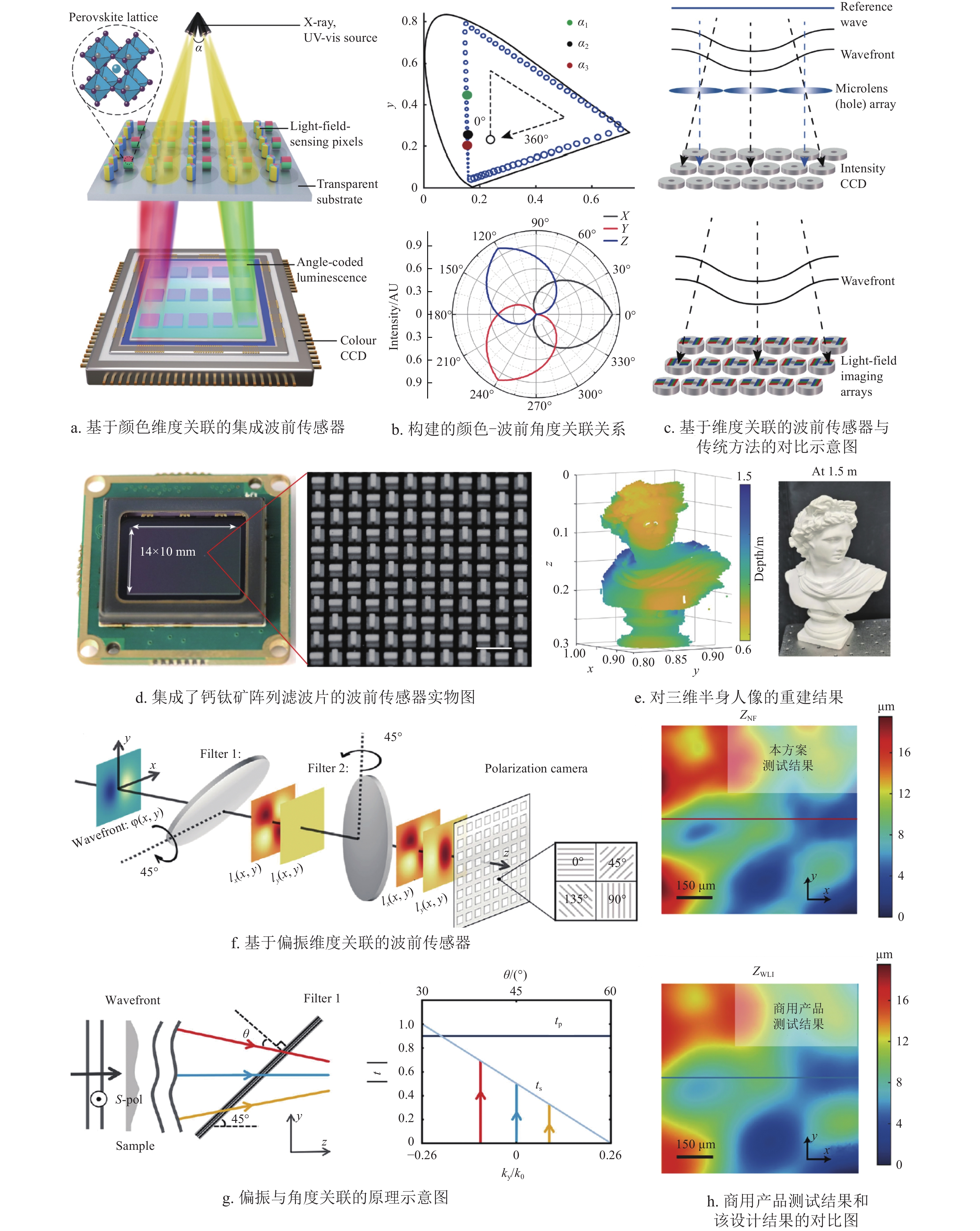Recent Advances in Optical Wavefront Sensing Technology
-
摘要: 光学波前是光波相位面的几何表示,光学波前传感技术通过检测光波传播路径中的相位变化来分析物体的性质。该技术广泛应用于大气湍流检测、光学元件缺陷分析、生物样品研究等领域,在天文学、自适应光学、显微成像、激光系统和生物医学等方面具有重要作用。然而,常见探测器仅对光强度敏感,为了探测光学波前,通常需要在探测前端使用一系列复杂的光学元件,这导致系统体积庞大、成本高昂且结构复杂。近年来,随着微纳光学和人工智能等领域的不断进展,涌现出一系列基于新原理、新器件和新算法的集成化、小型化和高性能的光学波前传感技术。该论文系统综述了近期光学波前传感技术的研究进展,并根据其原理将其分为干涉型和非干涉型两大类,具体包括剪切干涉型、光栅干涉型、近场干涉型、算法重构型和维度关联型等技术。最后,总结了当前领域尚存的挑战,并展望了未来可能的研究方向。Abstract: Optical wavefront is the geometric representation of the phase surface of light waves. Optical wavefront sensing technology analyzes the properties of objects by detecting phase changes in the light wave propagation path. This technology is widely used in atmospheric turbulence detection, optical element defect analysis, and biological sample research, playing a crucial role in fields such as astronomy, adaptive optics, microscopic imaging, laser systems, and biomedicine. However, common detectors are only sensitive to light intensity. To detect optical wavefronts, a series of complex optical components are typically required at the detection front end, leading to large system sizes, high costs, and structural complexity. In recent years, with continuous advancements in micro-nano optics and artificial intelligence, a series of integrated, miniaturized, and high-performance optical wavefront sensing technologies based on new principles, devices, and algorithms have emerged. This paper systematically reviews the recent research progress in optical wavefront sensing techniques, including two main types of interferometric and non-interferometric as well as typical methods: shear interferometry type, grating interferometry type, near-field interferometry type, algorithmic reconstruction type, and dimension-associated type. Finally, the current challenges in the field are summarized and the future development directions prospected.
-
光学波前是光波相位面的几何表示,能够反映光波在传播过程中的各种物理特性[1]。光学波前传感技术通过检测光波前的相位变化来分析物体的性质和状态,是现代光学和光电子学的重要研究方向[2-4]。如在天文学方面,由于地球大气层的湍流,光波在通过大气时会发生畸变,导致观测到的天体图像模糊不清[5];在微成像方面,样品自身的非均匀性和显微系统的缺陷会导致波前畸变,最终限制高分辨率成像结果[6];在激光系统中,环境因素和系统元件导致的波前畸变,也会最终限制激光在激光加工、激光通信、激光武器等方面的作用精度和距离[7]。然而,因为传统的光学探测器如CCD和CMOS传感器只能检测光的强度,而无法直接获取相位信息,因此为了实现波前测量,通常需要设计复杂的光学系统如干涉仪或者前置微透镜阵列等[8]。这些系统通过干涉或其他光学原理,将相位信息转换为强度变化,从而间接测量波前相位[9]。尽管光学波前传感技术在多个领域取得了显著进展,但由于传统系统设计复杂、体积庞大、成本高昂等问题,实际应用中仍存在诸多挑战。常见的波前传感器,如沙克−哈特曼波前传感器[10]、干涉仪[11]和曲率传感器[12]等,虽然能够提供高精度的波前测量,但其系统复杂性和设备成本限制了在便携设备和大规模应用中的推广。
1. 光学波前传感研究进展
近年来,随着微纳光学[13-17]、人工智能[18-19]等研究领域的快速发展,涌现出了一系列基于新原理、新结构和新算法的光学波前传感技术。其中,超构表面光学微分器的提出尤为具有代表性[20-23]。通过精巧布置二维排列的亚波长尺度人工结构,可以精确控制光的相位、振幅和偏振状态,并在角谱空间对光信号进行直接操作,从而在超薄尺寸内实现对光场实空间分布的一阶或高阶微分操作,这极大地提高了光学波前畸变提取的效率。此外,随着优化算法和计算能力的不断进步,可以通过直接分析传统光强成像结果,并结合空间光调制器等波前校正单元,精准判断波前畸变[24-26]。这不仅简化了系统设计,还提升了系统的鲁棒性和灵活性。另一个值得关注的发展是从维度关联的角度实现波前传感的新思路。通过构建波前维度与偏振[27]、颜色[28]维度的数据关联性,可以将原本复杂的波前传感问题转换为更容易处理的偏振或颜色传感问题,尽管这一方法目前仍处于初始发展阶段。总之,尽管光学波前传感技术的发展历史悠久,但近年来我们见证了一系列新型技术的涌现,展现了这一领域的蓬勃生机与创新潜力[29]。
本文将系统梳理近年来光学波前传感技术的研究进展。传统上,因为光学波前传感技术的原理非常多样,所以并没有一个非常清晰的分类方法,往往根据其技术特点分为剪切干涉波前传感技术、夏克−哈特曼波前传感技术、波前曲率传感技术、无须传感器的像清晰化波前传感技术等。近年来,涌现的一系列新型波前传感技术如维度关联技术则又无法被归为上述分类,且以多波横向剪切干涉技术为代表的最新一代商用技术也使得剪切干涉波前传感技术与夏克−哈特曼波前传感技术之间的界限越来越模糊。有鉴于此,本文在综述中无意对过去所有光学波前传感技术进行分类梳理,而是重点关注近年来以维度关联为代表的新型波前探测原理、以超构表面为代表的新型波前探测结构,以及以无探测器(sensor-less)传感为代表的新型波前提取算法,如图1所示。根据测量目标是否直接依赖于光场不同位置的相位差及其干涉图案,本文将近年来报道的光场传感技术分为干涉型和非干涉型两大类。其中,干涉型波前传感技术包括剪切干涉型、光栅干涉型和近场干涉型3种,而非干涉型技术则包括算法重构型和维度关联型两种。剪切干涉型传感将同一光束平移剪切距离来实现干涉;光栅干涉型传感借助透镜的傅里叶变化性质和光栅的衍射特性来进行波前传感;近场干涉型传感借助波长级结构对光的影响来进行传感;维度关联型传感将波前维度映射至其他维度上;算法重构型传感对已有的信息进行大量计算来还原波前。在下文中,我们将详细介绍各个类型的技术原理、发展脉络以及优缺点等。最后,我们也将对该领域进行总结和展望。
2. 干涉型光学波前传感技术
干涉型光学波前传感技术,其特征在于测量结果与入射光平面不同位置的相位差及其干涉图案密切相关。以剪切干涉为例,通过将入射光束分成两份并在空间上使二者发生横向偏移后再合束发生干涉,则此时光束强度便与两份分束光的相位差有关,对应初始光场的波前畸变信息。此外,以夏克−哈特曼波前传感技术为代表的光栅干涉型技术则是通过光栅阵列对入射光进行调制,并基于光的传播干涉原理在焦平面处得到入射光场的傅里叶变换分量,对应光场的角谱信息。最后,通过使用一些人工结构,如非厄米耦合亚波长结构等,也可以在近场实现光束的增强干涉效果,放大波前畸变对光场强度分布的影响,从而提高波前传感灵敏度,这便是近场干涉型波前传感技术。
2.1 剪切干涉型
剪切干涉型光学波前传感技术是目前使用较为广泛的一种波前传感方式,其原理是通过对波前进行空间剪切,产生两个相互平行但偏移一定距离的波前,然后让这两个波前相互干涉从而形成干涉图样,随后通过分析干涉图样可以获得波前的梯度信息,进而重构出原始波前。该技术具有光路设计简单、灵敏度高等优势,但同时存在动态范围有限、相位包裹、对噪声敏感、数据处理复杂等问题。具体来说,剪切距离是剪切干涉中最为重要的关键参数之一,对干涉图样的生成、波前梯度的测量以及最终波前重构的精度都有重要影响。针对波前梯度较小的情况,需要选择较大的剪切距离,这样可以有较高的灵敏度;而针对梯度较大的情况,则又需要选择较小的剪切距离,不然会导致相位包裹,无法准确反映波前的细微变化。然而,实际情况中的光场相位则可能同时存在低频和高频信息,导致剪切距离选取无法总是最优。此外,在剪切干涉仪的应用上,应用最广泛的是生物探测中用于加强透明物体成像质量的微分干涉对比(Differential Interference Contrast, DIC)显微镜,但传统的微分干涉对比显微镜仅仅通过剪切干涉显示出明暗变化,并不能给出定量的相位差信息[30]。就实现方式而言,传统上主要是使用分光棱镜或光学各向异性平板来完成这一过程,存在调节困难、系统复杂等问题。
近年来,随着以超构表面为代表的微纳光学元件在原理、设计、加工等方面的快速进步,它们也被用到了剪切干涉波前传感技术中,可以较大地简化原有的系统复杂度,并在性能和功能两方面都实现提升。如2020年文献[31]提出了一种基于多功能介电超表面的紧凑型定量相位梯度显微镜,利用超表面的多功能性和紧凑性,实现了单次拍摄获取三幅微分干涉对比图像,从而生成定量相位梯度图像(图2a),较传统需要复杂且笨重光学装置的定量相位成像系统在小型化应用方面有明显优势。具体原理在于,利用第一层超表面将不同偏振方向的光分到3个方向,随后由设计的第二层超表面形成具有不同相位偏移的3幅微分干涉对比图像(图2b)。然而,双层超构表面的设计较为复杂,所以后续有一些工作尝试基于单个超构表面实现剪切干涉波前传感。2022年,文献[32]报道了一种傅里叶光学自旋分裂显微镜,装置如图2c所示。该显微镜主要由一个4f成像系统组成,在傅里叶平面处放置了一个具有几何相位排布的超构表面,可将入射光分为具有相反圆偏振态的两束光,实现干涉。通过平移元表面捕获不同偏置延迟的多帧图像,可以提取相位信息,随后结合偏振相机获取具有不同偏置延迟的图像,最终实现单次定量相位成像(图2d)。一般来说,剪切干涉是探测波前沿着某一直线方向的相位梯度,但在某些应用如各向同性测试中研究人员对径向方向会更感兴趣。有鉴于此,2023年,文献[33]设计并实验验证了一种基于单层超表面的各向同性微分干涉对比显微镜,利用径向对称剪切在极坐标下进行相位调制,可以通过单次拍摄实现对微米颗粒的实时跟踪,且在强散射背景下也能保持较高精度(图2e)。上述工作都仍是针对某一个方向的相位梯度测量,并没有提供光场的完整信息。2024年,文献[34]提出了一种利用单层超透镜进行复杂振幅成像的极其紧凑的系统,该系统能够生成空间复用和偏振相移的点扩散函数,通过偏振相机同时记录4个偏振剪切干涉图案,从而实现一次性确定性重建复杂振幅光场(图2f)。其核心创新在于借用了0°、45°、90°和135°偏振检测通道记录光场在不同方向上的剪切干涉图案信息,随后基于四步相移方法计算x和y方向的相位梯度,并使用高阶有限差分最小二乘积分方法重建二维相位图像。
2.2 光栅干涉型
光栅干涉型波前传感器的典型代表是夏克−哈特曼波前探测器(Shack-Hartmann Wavefront Sensor, SHWS)。该传感器通过微透镜阵列测量每个分割波前的斜率来重建整个波前。然而,在波前分析和复原过程中,如果将微透镜阵列视作独立的小单元,忽略其衍射影响,会导致计算误差。因此,在实际使用中,往往将夏克−哈特曼波前探测器的微透镜阵列视为一个广义的光栅干涉仪。值得一提的是,最新一代的商用波前传感产品(如法国Phasics公司的SID4波前分析仪)便是将微透镜阵列替换为特制光栅。这种技术充分考虑了各单元之间的干涉,从干涉图案中反演出入射光波前信息,即多波剪切干涉技术[35-37]。此外,角度敏感像素(Angle-Sensitive Pixel, ASP)作为另一种已经被使用的波前传感技术,也是通过在传统光电探测器前放置微结构光栅阵列,利用光的干涉和衍射效应(Talbot效应)实现对不同入射角度的光的不同透射响应[38-40]。最后,基于超构光栅也可以实现对不同角度入射光的滤波[41-43]。综上所述,本文使用了光栅干涉型而非夏克−哈特曼型来概括这一大类技术。
传统光栅干涉型波前传感技术除了空间分辨较差等耳熟能详的问题,还存在诸如难以应对矢量光场光照、不同波段光照、不均匀光照等不足,而微纳光学与人工智能领域的发展也对该技术提供了更多选择和改进方案。有鉴于此,文献[44]提出了一种基于硅基超透镜的广义夏克−哈特曼阵列,不仅能够实时进行光束诊断,还可以通过分析焦点位移同时检测相位梯度剖面。该系统由超透镜阵列和标准相机组成,如图3a所示,基于偏振敏感超构透镜阵列的夏克−哈特曼型波前传感器,可实现对偏振和波前的同时检测。其中每个阵列像素由6个不同的超透镜子阵列组成(图3b),通过布置椭圆形硅柱的不同尺寸和取向角,可以调控透射光的透射强度(图3c)以及相位(图3d),可以实现每个超透镜聚焦一个特定的偏振状态 ,包括0°偏振、45°偏振、90°偏振、135°偏振、左旋偏振和右旋偏振态。随后,通过测量6种不同偏振状态的焦点强度,可以计算得到4个斯托克斯参数,获取入射光的偏振信息(图3e~图3g)。然而,用6次测量获取4个偏振信息存在一定冗余,降低了空间分辨率,所以该团队之后又设计了包含4个子阵列的超构表面,进一步提高了系统的空间分辨率和聚焦效率[45]。其中,空间分辨率提高了1.5倍,而平均聚焦效率从28%提高到48%。传统的夏克−哈特曼波前传感技术需要计算每个子透镜测得的波前斜率,并据此重建波前。为提高其在复杂探测任务中的传感准确性,文献[24]于2020年报道了一种新算法,通过卷积神经网络直接从夏克−哈特曼波前传感图案中预测波前分布,而无须进行波前斜率测量或者Zernike系数计算,显著提高了波前检测的准确性和速度,如图3h所示,深度学习算法加速的夏克−哈特曼波前传感器,利用深度学习处理复杂映射关系的能力,将原本需要先计算每个微透镜所在的波前斜率改进为通过整体的成像图案直接还原波前。除此之外,文献[46]也证实深度卷积神经网络可以有效改善夏克−哈特曼波前传感器在非均匀照明条件下的波前提取精度。
正如前文所说,虽然目前大量研究仍然是针对夏克−哈特曼波前传感技术做进一步优化,但基于相位光栅板的四波前横向剪切干涉技术波前传感器自2000年左右诞生并逐渐成熟商用化后,备受大家的关注,被认为是可以替代夏克−哈特曼波前传感器的技术。就细节而言,这种波前传感器使用一个棋盘状的相位光栅板取代微透镜阵列,交替在“棋盘格”上排列无相位块和+π相位块,使在每个局部都可以产生四向剪切干涉,大大提升了波前传感中的空间分辨率和相位分辨率。在该技术的基础上也有一些新算法方面的工作,如文献[47]的研究就将单次快照压缩成像与四波前剪切干涉相结合,运用神经网络重建波前,完成了一种超光谱波前传感技术。
2.3 近场干涉型
无论是剪切干涉型还是光栅干涉型光学波前传感技术,都是依赖于光场的远场干涉,即只考虑可以在自由空间传播的光的叠加。当光场被一个光阑调制时,在其波长范围内还存在光学近场,即横向空间波矢大于自由空间波矢的光场分量[1],部分光在平行于传播方向上具有虚的波矢,因此不对外传输能量。在传统的光学系统设计中,由于元件之间的间距远大于光的波长,光学近场效应通常可以被忽略,因此也未被用于波前传感。然而,近期的一些研究显示,光学近场甚至具有远超远场的干涉灵敏度,其背后的机理往往与光学微纳结构有关[48-50]。
如:传统夏克−哈特曼型及剪切干涉型光学波前传感器存在的最突出的一个问题就是非常低的空间分辨率,这是因为在远场干涉中空间域与频率域的分辨率存在互相制约的关系。2021年文献[51]使用微米级谐振器的近场耦合效应来开发超小型角度传感器,在能量利用效率为25%的条件下,将波前传感的空间采样密度较传统方法提高了两个数量级,达到了
9246 点/mm2。相比之下,商用夏克−哈特曼波前传感器的空间采样密度只有44点/mm2。其背后的设计细节在于,当光场入射在波长级别的孔径时,会由于近场效应而根据入射的角度不同在孔径后产生不同的光场分布,通过在孔径中不同位置光场强度的差异就可以还原出入射光的角度,从而在微米级的空间分辨率重建光场(图4a)。近场耦合也可以通过光纤结构实现。如文献[52]报道了一种基于光子灯笼模式转换器的全光子焦平面波前传感器,只需要通过测量单模输出阵列的强度,就可以重建入射波前的相位和幅度信息。如图4b所示,光子灯笼模式转换器的输入光场在从多模光纤到多芯光纤的过渡中会在光子灯笼结构中经历近场耦合作用,从而建立输入波前分布与输出光纤强度分布的关联函数,随后通过深度学习可以将多芯光纤的强度分布还原为多模光纤的波前分布。此外,由于输入相位和输出强度之间的关系是非线性的,因此可以使用深度神经网络来重建波前,同时保证波前传感的速度和精度。是否可以利用一个尺寸小于波长的装置实现对波源方向的精准定位?这个问题不仅对于实现超高空间分辨率的光学波前传感有意义,在其他领域也是一个好问题。早在2001年,文献[53-54]就讨论了寄生蝇(Ormia ochracea)是如何听声辨位的这个问题。尽管寄生蝇的耳膜间距小于0.5 mm,定位线索只在50 ns左右,但它们仍能精确定位声源。相比于人类的听觉系统依赖于两个耳朵中感受器反应的相对时间来确定声波的方位信息,寄生蝇的耳膜间距甚至小于0.5 mm(较人类小两个数量级),计算可得两耳感受到的声波相位差仅为0.07倍波长,但他们竟然可以达到与人类相当的听音辨方位能力。研究发现,寄生蝇的两个耳膜是通过空腔耦合在一起的,这种深亚波长的机械振动耦合系统可以将入射波的相位差值放大近40倍,且两侧鼓膜的振动幅值也有较大差异,类似的现象也出现在其他小动物身上,如图4c所示,以守宫蜥蜴为代表的小型动物可以通过内部耦合的鼓膜实现对声源方向的精准判断。受寄生蝇听觉系统的启发,声学领域的研究人员也做了一些仿生设计[55],包括利用多个压电传感端口同时转换传感结构的两个正交振动模式,从而实现同时测量声压和压力梯度[56]。但直到2018年,基于上述机理的仿生学波前传感设计才第一次在文献[57]中被报道。文献[57]的研究利用两个紧密间隔的谐振硅纳米线,实现了电学隔离和光学耦合,如图4d所示,设计的光学耦合而电学隔离的亚波长纳米线结构,其吸收可通过光电流直接读取。当这些共振器将光散射到相同的自由空间光模式中时,会产生非厄米耦合,从而实现高灵敏度的角度测量(图4e)。通过简单的光电流测量,独立量化每根纳米线中的存储光能,并将两根纳米线之间的存储能量差异与光波的入射角度联系起来,就可以还原出入射光的角度信息,并最终在实验中测到了0.32°的角度敏感度。值得注意的是,这种耦合是发生在近场的,所以当把两根纳米线间距调整至大于波长,即使两者之间存在更大的相位差,但其导致的光场分布不均却变得更弱甚至消失了,如图4f所示,小于波长的间距时二者产生耦合而对角度有响应,大于波长的间距时不会产生耦合,各自独立。如果使用两个这样的亚波长角度光探测器,则可以通过三角测量法实现对光源位置的实验测量[58]。
3. 非干涉型光学波前传感技术
非干涉型光学波前传感技术的特点是其测量结果不依赖于入射光在平面上不同位置的相位差及其干涉图案,而是利用其他信息来恢复波前。如可以通过相位恢复算法,直接分析采集到的振幅数据,并通过迭代投影的方法重建波前相位信息。近年来,一些新方法通过将波前信息关联到其他维度来进行传感,这些方法利用了已经成熟的其他维度传感器来替代尚未成熟的波前传感器,也展现出极大的潜力和启发性。
3.1 算法重构型
算法型波前传感是发展时间较长,应用相对广泛的波前传感技术。在最初波前传感器尚未成熟时,研究人员希望能够通过算法从振幅测量值直接重建出该信号的完整复数形式(包括振幅和相位)。传统的相位恢复算法如Gerchberg-saxton算法,在随机化初始相位后,通过在空间域和频率域的反复迭代恢复信号的相位信息,在后续的发展中,通过采集更多初始信息来增强恢复效率的算法也相继诞生,如强度传输方程。这些传统方法都严格遵循采样定律,即采集数据维度需要大于恢复后的数据维度以保证恢复的唯一性。随着人工智能技术的发展进步,以稀疏性假设为核心的压缩感知算法被成功地应用于波前传感领域,这类算法不要求采集数据维度,通过更少的数据就可以恢复波前相位信息。传统的相位恢复算法普适性较差,强度传输方程等方法需要借助多个焦面的数据采集,实时性受到影响,人工智能方法依赖于大量的标记数据,训练周期长且鲁棒性、可解释性较差。为解决人工智能算法需要大量标记数据训练的问题,将物理模型融入神经网络成为了新的发展方向。
作为对传统相位恢复算法的成功应用,2019年,文献[25]提出的高分辨率波前成像传感器(Wavefront Imaging Sensor with High resolution, WISH)大大提高了波前传感器的像素分辨率。WISH具有
1000 万像素的空间分辨率,比传统SHWFS高出3个数量级,其主要原理是通过SLM代替微透镜阵列,并通过随机SLM图案调制入射光场(图5a),接着使用迭代相位恢复算法将采集到的高维图像恢复为波前相位。这一装置可以重建直径为 76.2 mm的菲涅尔透镜的复振幅和相位信息达微米级别(图5b),具有很好的远距离成像能力。随着微纳光学的发展,通过光学硬件简化系统成为了新的研究趋势。如2019年文献[59]提出了一种受跳蛛眼睛启发的紧凑型单次拍摄金属透镜深度传感器。使用金属超构透镜技术,通过一个光圈同时捕捉到两幅不同散焦的图像,并在单个平面光电传感器的不同区域同时形成这两幅图像(图5c),通过高效的计算可实时恢复物体的深度信息(图5d)。这一方法可以视作对入射球面波进行的波前传感,如修改算法为强度传输方程相位恢复算法即可得到一个高实时性的波前传感器。2018年,文献[60]提出了一种结合波前采样和光束位置检测器的相位成像技术。他们首先使用高频率空间光调制器生成了一系列二进制振幅掩模,接着通过单一聚焦透镜形成对不同掩模的不同光分布,即对波前进行采样,这样,可以在不依靠迭代算法或相位展开算法的情况下确定地还原波前相位信息。除了图像处理方面的算法优化,文献[61]开发了一种基于全光学衍射编码和解码的亚波长成像方法,能够在紧凑设计下实现物体相位和振幅的亚波长成像,属于硬件加速方法。3.2 维度关联型
在特定的空间位置,光学波前传感需要测量3个关键参数:光强、波前法线的极角和方位角。从数学上讲,这要求进行多次测量,并在其他参量空间中找到能够存储多维信息的空间。在剪切干涉中,这可以通过改变剪切方向和相位差在不同时间实现;在光栅干涉中,则通过在不同空间位置划分超单元结构实现。然而,占用时间或空间信息必然会导致波前传感在时间分辨率或空间分辨率方面的损失,不利于对高动态复杂波前目标的探测。此外,波前法线角度与波前梯度相关,反映了光场在频率域的信息,但由于空间域和频率域通过傅里叶变换关联,常常存在空间分辨率与相位分辨率之间的制约关系。如商用夏克−哈特曼传感器普遍只有几千像素。虽然四波前剪切干涉技术具有比夏克−哈特曼传感器更高的空间分辨率,但仍然只有几万像素水平,并且需要大量计算从复杂干涉条纹中反演得到原始波前信息,导致处理速度较慢。
除了光强、位置和相位外,光场还携带了颜色和偏振等其他维度的信息。在颜色特性或偏振特性并非研究重点的情况下(如透明物体或各向同性物体),可以考虑将颜色维度或偏振维度作为感知和存储光场信息的参量空间。这种做法有三方面潜在的优势:1)这种新型关联方式避开了对时间或空间信息的占用,有望解决波前传感中时空分辨率低的瓶颈问题;2)这种关联不需要求解复杂的干涉条纹,有望实现高实时性的波前传感技术;3)相比于光场相机,彩色相机和偏振相机的感知能力已经发展较为成熟,且后者的价格普遍较前者低一个数量级,而其像素规模则往往高两个数量级。
文献[28]于2023年提出了一种基于光栅图案化钙钛矿纳米晶体阵列的波前检测方法(图6a),可以将特定方向的光线转换为像素化的颜色输出(图6b),从而实现了对入射光波前的直接探测(图6c),大大提高了波前探测系统的集成度。该方法的特点在于拥有两组垂直排列的品字形像素化钙钛矿纳米晶体阵列,以及可直接放置于商用彩色数字相机上方,从而制作成小型的波前相机(图6d)。得益于无机钙钛矿纳米晶体在光电性能及发光特性的优异性能,该设计的工作波段覆盖从X射线到可见光(0.002~550 nm),且在此范围内具有
0.0018 °的角分辨率,可以很好地实现三维成像和光检测及测距等功能(图6e)。除了颜色维度关联之外,同年,文献[27]报道了一种基于偏振维度关联的波前传感技术(图6f)。利用两块具有角度−偏振依赖响应的非局域多层介质薄膜滤波器,使入射光场的二维相位梯度被分别映射到x和y偏振光的强度变化上(图6g),然后由偏振相机拍摄图像,从而实现单次拍摄的二维波前重构。这种方法大大简化了测试系统,对比此方案和商用产品的测试结果差异较小,具有很高的完成度(图6h)。4. 结束语
光学波前传感技术在天文学、自适应光学、生物显微、激光通信等多个应用中都已经体现了其不可或缺的重要价值,但其发展仍面临多方面的诸多挑战,包括高空间分辨率、高精度、实时处理、高动态范围和环境适应性等。如目前普通商用相机的探测器阵列规模通常在千万像素以上,而当前主流的夏克−哈特曼波前传感器的空间采样点则只有几千像素(数据来自Thorlabs公司),其价格约为数万元人民币。相比之下,空间采样点更多的四波横向剪切干涉技术可以达到几万像素水平(数据来自Phasics公司),但其价格更为昂贵。总体而言,能够感知波前的光学传感器在空间采样点数量上与普通商用相机相比存在约3个数量级的差距。此外,目前的波前传感技术实际测得的是散射或干涉图案等,这些图案与原始波前信息之间的关联并不直观,需要经过后期计算才能重构出原始波前信息,这就需要强大的计算能力和高效的算法。然而,现有的计算硬件和算法能力有限,导致在处理复杂波前数据时,难以达到理想的实时性和效率,进而在一定程度上限制了其在高能激光器、高功率激光传输、大型天文望远镜等需要快速动态实时检测波前的领域中的应用。而在应用场景方面,针对生物样本中波前畸变大、高频信息多等特点的光学波前传感技术目前也发展不够成熟,需要进一步提升其相位测量范围和空间采样频率。
本文总结的近年来基于新原理、新结构、新算法的光学波前传感技术为解决该领域瓶颈问题提供了新的思路。展望未来,本文认为可以着重关注如下几个方面的研究。
1)在新原理方面,研究基于维度关联的光学波前传感技术。传统上,夏克−哈特曼型和剪切干涉型波前传感技术基于光场在空间域和频率域之间的关联,这在数学上受到傅里叶变换的限制,因此很难同时提高空间分辨率和频率分辨率。近期的一些研究工作则尝试充分利用光场的其他维度(如颜色、偏振等),以突破传统空间域−频率域转换的限制,从而解决上述瓶颈问题。然而,这一研究方向仍存在一些基础问题:一方面,相关基础理论尚不成熟,目前尚不清楚在理论层面上,维度关联方法是否真的能够实现同时具备高空间分辨率和高相位分辨率的波前传感技术;另一方面,已有的研究工作尚未在空间分辨率方面显示出明显优势,并且需要多次测试,这表明不同维度之间的关联尚未得到优化。
2)在新结构方面,研究基于微纳光学的光学波前传感技术。光学微纳结构能够对光波的相位、振幅和偏振状态进行精确调控,且其厚度通常仅为几百纳米,这可以显著减小光学系统的体积和重量,对于便携式和空间受限的应用尤为重要[62]。值得一提的是,具有非局域响应特性的光学微纳结构还可以实现对光场在频率域的直接操控,而这一点在传统方法中需要通过复杂的光学系统才能实现。此外,光学微纳结构通过结合多种光学维度(如相位、振幅、偏振和颜色),可以达成多维度信息融合的效果,从而实现更高精度和更高分辨率的波前传感。然而,基于微纳结构的波前传感技术尚未被广泛应用,主要原因在于加工难度较大且成本较高。此外,当前的研究工作中,这些结构在实际应用中体现出的优势并不显著,因此进一步的发展和优化仍然需要大量研究与验证。
3)在新算法方面,研究具有新型波前调制以及解调算法的光学波前传感技术。随着波前传感技术的不断发展,除了传统的波前数据重构需求外,在噪声过滤、实时处理和多维度融合等方面,也需要更加先进的算法和更强大的计算能力,以提供更准确、更快速和更全面的波前传感性能。尽管目前已有一些相关工作报道,但在适用性和处理速度等方面仍存在不足。未来的研究应充分利用以下几个方向:利用机器学习和深度学习技术提高波前重构的精度和速度;设计面向复杂动态光学环境的自适应算法;针对多维度波前数据设计相应的优化算法;探索量子计算在波前传感中的应用。
4)在新器件方面,研究可同时测量偏振、波长等光学维度的多功能光学波前传感技术。传统的波前传感技术主要提供待测物体对光学相位的影响信息。通过提升其对光学其他维度(如偏振、光谱等信息)的感知能力,可以进一步获取物体的折射率、物质成分、应力分布等更为丰富的信息,这对于生化医疗等领域具有重要意义[40, 44, 63]。然而,目前多维光场探测技术尚不成熟,提升维度探测的同时往往会伴随着时间分辨率或者空间分辨率的下降。如何在不过多牺牲时空分辨率的前提下,实现对更多光学维度的探测,是一个亟待解决的问题。
本文总结了近年来一系列具有新原理、新结构、新算法的光学波前传感技术的研究进展,并介绍了光栅干涉型、剪切干涉型、结构辅助型、算法重构型和维度关联型等各个研究方向的技术原理和发展脉络。目前,波前传感技术已经广泛应用于天文学、自适应光学、显微成像、激光系统和生物医学等诸多领域,而更为小型化、低成本、高性能、高分辨率的新型波前传感技术则有望推动上述领域的应用变革。
-
[1] BORN M, WOLF E. Principles of optics[M]. Cambridge, UK: Cambridge University Press, 2019.
[2] CARBILLET M, FERRARI A, AIME C, et al. Wavefront sensing: From historical roots to the state-of-the-art[J]. European Astronomical Society Publications Series, 2006, 22: 165-185.
[3] SALEH B E A, TEICH M C. Fundamentals of photonics[M]. Hoboken, NJ: Wiley-Interscience, 2001.
[4] 张以谟. 现代应用光学[M]. 北京: 电子工业出版社, 2018. ZHANG Y M. Contemporary applied optics[M]. Beijing: Publishing House of Electronics Industry, 2018.
[5] BARCHERS J D, FRIED D L, LINK D J. Evaluation of the performance of Hartmann sensors in strong scintillation[J]. Applied Optics, 2002, 41(6): 1012-1021. DOI: 10.1364/AO.41.001012
[6] EVANKO D, HEINRICHS A, ROSENTHAL C. Milestones in light microscopy[J]. Nature Cell Biol, 2009, 11: 5-20.
[7] SALTER P S, BOOTH M J. Adaptive optics in laser processing[J]. Light: Science & Applications, 2019, 8(1): 110.
[8] YUAN S, MA C, FETAYA E, et al. Geometric deep optical sensing[J]. Science, 2023, 379(6637): eade1220. DOI: 10.1126/science.ade1220
[9] TYO J S, TURNER T S. Variable-retardance, fourier-transform imaging spectropolarimeters for visible spectrum remote sensing[J]. Applied Optics, 2001, 40(9): 1450-1458. DOI: 10.1364/AO.40.001450
[10] PLATT B C, SHACK R. History and principles of Shack-Hartmann wavefront sensing[J]. Journal of Refractive Surgery, 2001, 17(5): S573-S577.
[11] LANG W. Nomarski differential interference-contrast microscopy[J]. Zeiss Information, 1968(70):114-120.
[12] RODDIER F. Curvature sensing and compensation: A new concept in adaptive optics[J]. Applied Optics, 1988, 27(7): 1223-1225. DOI: 10.1364/AO.27.001223
[13] KIM I, MARTINS R J, JANG J, et al. Nanophotonics for light detection and ranging technology[J]. Nature Nanotechnology, 2021, 16(5): 508-524. DOI: 10.1038/s41565-021-00895-3
[14] NESHEV D N, MIROSHNICHENKO A E. Enabling smart vision with metasurfaces[J]. Nature Photonics, 2023, 17(1): 26-35. DOI: 10.1038/s41566-022-01126-4
[15] WEI J, LI Y, WANG L, et al. Zero-bias mid-infrared graphene photodetectors with bulk photoresponse and calibration-free polarization detection[J]. Nature Communications, 2020, 11(1): 6404. DOI: 10.1038/s41467-020-20115-1
[16] WEI J, XU C, DONG B, et al. Mid-infrared semimetal polarization detectors with configurable polarity transition[J]. Nature Photonics, 2021, 15(8): 614-621. DOI: 10.1038/s41566-021-00819-6
[17] WEI J X, CHEN Y, LI Y, et al. Geometric filterless photodetectors for mid-infrared spin light[J]. Nature Photonics, 2023, 17: 171-178.
[18] REN Z, ZHANG Z, WEI J, et al. Wavelength-multiplexed hook nanoantennas for machine learning enabled mid-infrared spectroscopy[J]. Nature Communications, 2022, 13(1): 3859. DOI: 10.1038/s41467-022-31520-z
[19] MA C, YUAN S F, CHEUNG P, et al. Intelligent infrared sensing enabled by tunable moiré quantum geometry[J]. Nature, 2022, 604(7905): 266-272. DOI: 10.1038/s41586-022-04548-w
[20] SILVA A, MONTICONE F, CASTALDI G, et al. Performing mathematical operations with metamaterials[J]. Science, 2014, 343(6167): 160-163. DOI: 10.1126/science.1242818
[21] ZHOU Y, ZHENG H, KRAVCHENKO I I, et al. Flat optics for image differentiation[J]. Nature Photonics, 2020, 14(5): 316-323. DOI: 10.1038/s41566-020-0591-3
[22] ZHOU J, QIAN H, CHEN C F, et al. Optical edge detection based on high-efficiency dielectric metasurface[J]. Proceedings of the National Academy of Sciences, 2019, 116(23): 11137-11140. DOI: 10.1073/pnas.1820636116
[23] GUO C, XIAO M, MINKOV M, et al. Photonic crystal slab Laplace operator for image differentiation[J]. Optica, 2018, 5(3): 251. DOI: 10.1364/OPTICA.5.000251
[24] HU L, HU S, GONG W, et al. Deep learning assisted Shack-Hartmann wavefront sensor for direct wavefront detection[J]. Optics Letters, 2020, 45(13): 3741-3744. DOI: 10.1364/OL.395579
[25] WU Y, SHARMA M K, VEERARAGHAVAN A. WISH: Wavefront imaging sensor with high resolution[J]. Light, Science & Applications, 2019, 8: 44.
[26] HE C, ANTONELLO J, BOOTH M J. Vectorial adaptive optics[EB/OL]. [2024-07-16]. http://arxiv.org/abs/2110.02606v1.
[27] LI L, JIA W, JIN C, et al. Single‐shot wavefront sensing with nonlocal thin film optical filters[J]. Laser & Photonics Reviews, 2023, 17(12): 2300426.
[28] YI L Y, HOU B, ZHAO H, et al. X-ray-to-visible light-field detection through pixelated colour conversion[J]. Nature, 2023, 618(7964): 281-286. DOI: 10.1038/s41586-023-05978-w
[29] QU Y, YI S, YANG L, et al. Multimodal light-sensing pixel arrays[J]. Applied Physics Letters, 2022, 121(4): 040501. DOI: 10.1063/5.0090138
[30] PARK Y, DEPEURSINGE C, POPESCU G. Quantitative phase imaging in biomedicine[J]. Nature Photonics, 2018, 12(10): 578-589. DOI: 10.1038/s41566-018-0253-x
[31] KWON H, ARBABI E, KAMALI S M, et al. Single-shot quantitative phase gradient microscopy using a system of multifunctional metasurfaces[J]. Nature Photonics, 2020, 14: 109-114. DOI: 10.1038/s41566-019-0536-x
[32] ZHOU J, WU Q, ZHAO J, et al. Fourier optical spin splitting microscopy[J]. Physical Review Letters, 2022, 129(2): 020801. DOI: 10.1103/PhysRevLett.129.020801
[33] WANG X, WANG H, WANG J, et al. Single-shot isotropic differential interference contrast microscopy[J]. Nature Communications, 2023, 14(1): 2063. DOI: 10.1038/s41467-023-37606-6
[34] LI L, WANG S, ZHAO F, et al. Single-shot deterministic complex amplitude imaging with a single-layer metalens[J]. Science Advances, 2024, 10(1): eadl0501. DOI: 10.1126/sciadv.adl0501
[35] BON P, MAUCORT G, WATTELLIER B, et al. Quadriwave lateral shearing interferometry for quantitative phase microscopy of living cells[J]. Optics Express, 2009, 17(15): 13080-13094. DOI: 10.1364/OE.17.013080
[36] CHANTELOUP J C. Multiple-wave lateral shearing interferometry for wave-front sensing[J]. Applied Optics, 2005, 44(9): 1559. DOI: 10.1364/AO.44.001559
[37] 刘克, 张孝天, 钟慧, 等. 四波前横向剪切干涉仪的关键技术研究[J]. 光学学报, 2023, 43(15): 1512001. DOI: 10.3788/AOS230738 LIU K, ZHANG X T, ZHONG H, et al. Key technologies of quadri-wave lateral shearing interferometer[J]. Acta Optica Sinica, 2023, 43(15): 1512001. DOI: 10.3788/AOS230738
[38] SIVARAMAKRISHNAN S, WANG A, GILL P R, et al. Enhanced angle sensitive pixels for light field imaging[C]//Proceedings of the International Electron Devices Meeting. New York: IEEE, 2011.
[39] WANG A, GILL P, MOLNAR A. Angle sensitive pixels in CMOS for lensless 3D imaging[C]//Proceedings of the IEEE Custom Integrated Circuits Conference. New York: IEEE, 2009: 371-374.
[40] JAYASURIYA S, SIVARAMAKRISHNAN S, CHUANG E, et al. Dual light field and polarization imaging using CMOS diffractive image sensors[J]. Optics Letters, 2015, 40(10): 2433. DOI: 10.1364/OL.40.002433
[41] LIU J N, PAIELLA R. Gradient-metasurface directional photodetectors[J]. Optics Letters, 2024, 49(6): 1417. DOI: 10.1364/OL.509642
[42] LIU J, WANG H, LI Y, et al. Asymmetric metasurface photodetectors for single-shot quantitative phase imaging[J]. Nanophotonics, 2023, 12(17): 3519-3528. DOI: 10.1515/nanoph-2023-0354
[43] LIU J, WANG H, KOGOS L C, et al. Optical spatial filtering with plasmonic directional image sensors[J]. Optics Express, 2022, 30(16): 29074. DOI: 10.1364/OE.460556
[44] YANG Z, WANG Z, WANG Y, et al. Generalized Hartmann-Shack array of dielectric metalens sub-arrays for polarimetric beam profiling[J]. Nature Communications, 2018, 9(1): 4607. DOI: 10.1038/s41467-018-07056-6
[45] WANG Y, WANG Z, FENG X, et al. Dielectric metalens-based Hartmann–Shack array for a high-efficiency optical multiparameter detection system[J]. Photonics Research, 2020, 8(4): 482. DOI: 10.1364/PRJ.383772
[46] DUBOSE T B, GARDNER D F, WATNIK A T. Intensity-enhanced deep network wavefront reconstruction in Shack–Hartmann sensors[J]. Optics Letters, 2020, 45(7): 1699. DOI: 10.1364/OL.389895
[47] HOWARD S, ESSLINGER J, WANG R H W, et al. Hyperspectral compressive wavefront sensing[J]. High Power Laser Science and Engineering, 2023, 11: e32. DOI: 10.1017/hpl.2022.35
[48] ZHANG S, YE Z, WANG Y, et al. Anti-Hermitian plasmon coupling of an array of gold thin-film antennas for controlling light at the nanoscale[J]. Physical Review Letters, 2012, 109(19): 193902. DOI: 10.1103/PhysRevLett.109.193902
[49] KIM S J, KANG J H, MUTLU M, et al. Anti-Hermitian photodetector facilitating efficient subwavelength photon sorting[J]. Nature Communications, 2018, 9(1): 316. DOI: 10.1038/s41467-017-02496-y
[50] SMALLEY J S T, REN X, LEE J Y, et al. Subwavelength pixelated CMOS color sensors based on anti-Hermitian metasurface[J]. Nature Communications, 2020, 11(1): 3916. DOI: 10.1038/s41467-020-17743-y
[51] YI S, XIANG J, ZHOU M, et al. Angle-based wavefront sensing enabled by the near fields of flat optics[J]. Nature Communications, 2021, 12(1): 6002. DOI: 10.1038/s41467-021-26169-z
[52] NORRIS B R M, WEI J, BETTERS C H, et al. An all-photonic focal-plane wavefront sensor[J]. Nature Communications, 2020, 11(1): 5335. DOI: 10.1038/s41467-020-19117-w
[53] MASON A C, OSHINSKY M L, HOY R R. Hyperacute directional hearing in a microscale auditory system[J]. Nature, 2001, 410(6829): 686-690. DOI: 10.1038/35070564
[54] NARINS P M. In a fly’s ear[J]. Nature, 2001, 410(6829): 644-645. DOI: 10.1038/35070695
[55] LEE T, NOMURA T, SU X, et al. Fano-like acoustic resonance for subwavelength directional sensing: 0–360 degree measurement[J]. Advanced Science, 2020, 7(6): 1903101. DOI: 10.1002/advs.201903101
[56] KUNTZMAN M L, HALL N A. Sound source localization inspired by the ears of the O rmia ochracea[J]. Applied Physics Letters, 2014, 105(3): 033701. DOI: 10.1063/1.4887370
[57] YI S, ZHOU M, YU Z, et al. Subwavelength angle-sensing photodetectors inspired by directional hearing in small animals[J]. Nature Nanotechnology, 2018, 13(12): 1143-1147. DOI: 10.1038/s41565-018-0278-9
[58] PAN Q, SUN Y, SU M, et al. Circular subwavelength photodetectors for 3D space exploration[J]. Advanced Optical Materials, 2022, 10(6): 2102163. DOI: 10.1002/adom.202102163
[59] GUO Q, SHI Z, HUANG Y W, et al. Compact single-shot metalens depth sensors inspired by eyes of jumping spiders[J]. Proceedings of the National Academy of Sciences, 2019, 116(46): 22959-22965. DOI: 10.1073/pnas.1912154116
[60] SOLDEVILA F, DURÁN V, CLEMENTE P, et al. Phase imaging by spatial wavefront sampling[J]. Optica, 2018, 5(2): 164. DOI: 10.1364/OPTICA.5.000164
[61] HU J, LIAO K, DINÇ N U, et al. Subwavelength imaging using a solid-immersion diffractive optical processor[J]. eLight, 2024, 4(1): 8. DOI: 10.1186/s43593-024-00067-5
[62] 倪一博, 闻顺, 沈子程, 等. 基于超构表面的多维光场感知[J]. 中国激光, 2021, 48(19): 1918003. NI Y B, WEN S, SHEN Z C, et al. Multidimensional light field sensing based on metasurfaces[J] Chinese Journal of Lasers, 2021, 48(19): 1918003.
[63] 钟慧, 李艳秋, 刘克, 等. 嵌入式相位传感的多功能 Stokes-Mueller 偏振仪[J]. 光学学报, 2023, 43(2): 0212003. DOI: 10.3788/AOS221272 ZHONG H, LI Y Q, LIU K, et. al. Multifunctional stokes-mueller polarimeter based on embedded phase[J]. Acta Optica Sinica, 2023, 43(2): 0212003. DOI: 10.3788/AOS221272

 ISSN
ISSN 



 下载:
下载:
